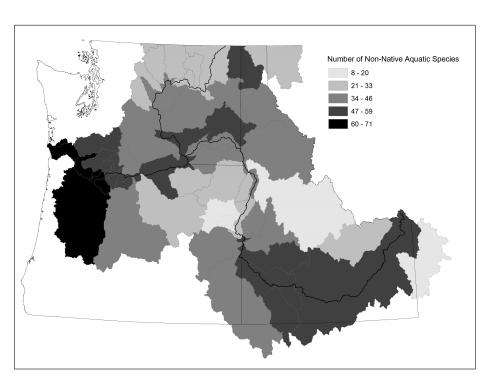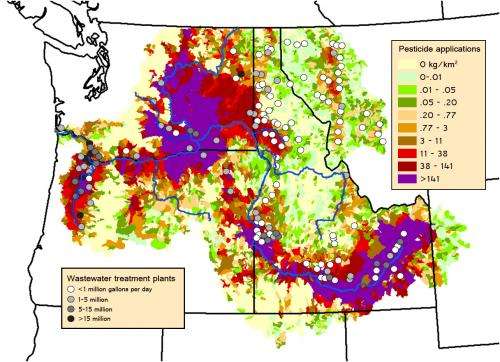Aquatic nonnative species – those found in the water but not including those on land alongside rivers and streams – are just one example of invasive species that can effect young salmon and foodwebs in the Columbia River Basin. Credit: K Barnas/B Sanderson/NOAA
(Phys.org)—Food webs needed by young salmon in the Columbia River basin are likely compromised in places, something that should be considered when prioritizing expensive restoration activities aimed at rebuilding endangered runs.
Right now there are probably too many young fish and not enough food in places. Taking hatchery fish and wild fish together, there are twice as many young salmon in the system today as there were before major hatchery and dam construction, say scientists in an article that went online today (Nov. 28) in the Proceedings of the National Academy of Sciences early edition.
The food web also is under assault from chemical contaminants as well as invasive species – and even a few native ones – that gang up on young salmon because of the way the river is managed.
"The Northwest Power and Conservation Council has a strong fish and wildlife program that is based on what's called the four Hs – hatcheries, harvest, hydrosystem and habitat," said lead author Robert J. Naiman, a University of Washington professor of aquatic and fishery sciences. "Our suggestion is that the fish and wildlife program needs to incorporate food web concerns to improve its effectiveness."
For example, habitat restoration may have been effective in places but overall it has not worked out as well as originally hoped and incorporating food webs might help, he said.
Food webs explore what eats what, as well as how much is eaten and where and when it is consumed. In the Columbia River, the web extends from tiny microbes, algae and insects to fish such as salmon and other top predators such as birds and bears.
Naiman led an effort considering food webs, concluded in 2011, for the Independent Scientific Advisory Board, a committee of scientists reporting to the Northwest Power and Conservation Council, National Oceanic and Atmospheric Administration and the Columbia Basin Tribes. The scientists found little existing information for the Columbia although they evaluated about 1,000 peer-reviewed papers and contacted more than 40 agency, tribal, university and private-sector scientists.
Three main concerns deserve more attention, they said.
Average yearly pesticide application from 1999-2004 – expressed as kilograms per square kilometer – and a growing number of wastewater treatment plants in the Columbia basin are reasons to learn more about such chemical inputs and food webs. Credit: Northwest Power and Conservation Council
Is there enough food in river for young fish?
Managers need to determine what's called the carrying capacity – how much food is available compared to how many fish are there – in stretches of the Columbia and its tributaries.
The team, for example, estimated that the 9 million wild and hatchery Chinook salmon passing between Lower Granite and Bonneville dams for two weeks in the spring of 2008 needed 166.5 metric tons of prey. It's the first time any group tried such a calculation.
"That's a lot of food for a section of river to produce," Naiman said.
One recommendation: To make better determinations of carrying capacity and manage fish releases from hatcheries to minimize the effects on the food web.
Artificial chemicals may compromise food webs
The best data available said there are 45,000 metric tons of pesticides applied to agricultural lands in the Columbia basin, and much of it close to the river and its tributaries. There are some 160 wastewater treatment plants adding chemicals and hormones from personal care products, flame retardants and other products that end up in waste water.
No one has yet studied the chemicals' effects on the Columbia food web, but in other rivers they are known to particularly affect the smaller members at the low end of the food web.
One recommendation: This is a complex issue that requires a focused effort and strong collaboration with the Environmental Protection Agency, U.S. Geological Survey, local communities, industry and regional governments.
Non-native and burgeoning native species create food webs never before seen
Managers and citizens need to accept that the Columbia River is composed of hybrid communities – a mixture of native and invasive species– and plan accordingly.
"The current system has food webs never before seen there," Naiman said.
More than 325 nonnatives have been found in the waters, with walleye pike and bass among the voracious predators of young salmon. Then because the river is so altered, there are explosions of native species too, including terns, cormorants, sea lions and northern pike minnows.
"The stark reality is that hybrid food webs will persist; nonnative species are widely established, and eradication will be difficult, if not impossible," the authors write.
One recommendation: Consider releasing fewer hatchery fish and doing it throughout the year instead of over just a few months. In theory, staggered releases confuse predators so their numbers would decline, Naiman said.
Among the paper's overall conclusions: "Habitat and food web approaches are compatible, and if better integrated, they could improve restoration effectiveness," the researchers write.
More information: www.pnas.org/content/early/201 … /1213408109.abstract
Journal information: Proceedings of the National Academy of Sciences
Provided by University of Washington





















